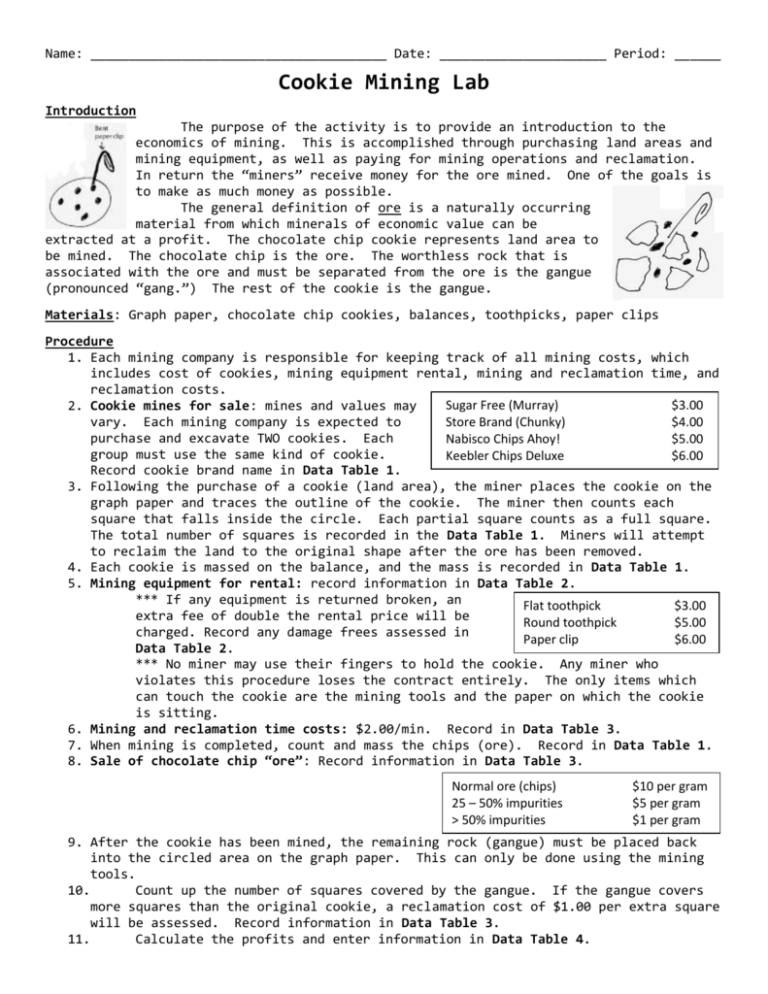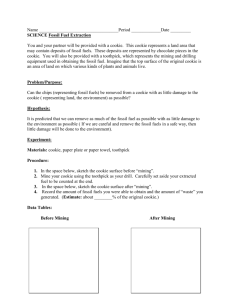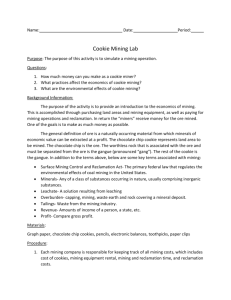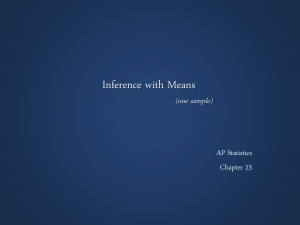Cookie Mining Lab - Liberty Union High School District
advertisement

Name: _______________________________________ Date: ______________________ Period: ______ Cookie Mining Lab Introduction The purpose of the activity is to provide an introduction to the economics of mining. This is accomplished through purchasing land areas and mining equipment, as well as paying for mining operations and reclamation. In return the “miners” receive money for the ore mined. One of the goals is to make as much money as possible. The general definition of ore is a naturally occurring material from which minerals of economic value can be extracted at a profit. The chocolate chip cookie represents land area to be mined. The chocolate chip is the ore. The worthless rock that is associated with the ore and must be separated from the ore is the gangue (pronounced “gang.”) The rest of the cookie is the gangue. Materials: Graph paper, chocolate chip cookies, balances, toothpicks, paper clips Procedure 1. Each mining company is responsible for keeping track of all mining costs, which includes cost of cookies, mining equipment rental, mining and reclamation time, and reclamation costs. Sugar Free (Murray) $3.00 2. Cookie mines for sale: mines and values may vary. Each mining company is expected to Store Brand (Chunky) $4.00 purchase and excavate TWO cookies. Each Nabisco Chips Ahoy! $5.00 group must use the same kind of cookie. Keebler Chips Deluxe $6.00 Record cookie brand name in Data Table 1. 3. Following the purchase of a cookie (land area), the miner places the cookie on the graph paper and traces the outline of the cookie. The miner then counts each square that falls inside the circle. Each partial square counts as a full square. The total number of squares is recorded in the Data Table 1. Miners will attempt to reclaim the land to the original shape after the ore has been removed. 4. Each cookie is massed on the balance, and the mass is recorded in Data Table 1. 5. Mining equipment for rental: record information in Data Table 2. *** If any equipment is returned broken, an Flat toothpick $3.00 extra fee of double the rental price will be Round toothpick $5.00 charged. Record any damage frees assessed in Paper clip $6.00 Data Table 2. *** No miner may use their fingers to hold the cookie. Any miner who violates this procedure loses the contract entirely. The only items which can touch the cookie are the mining tools and the paper on which the cookie is sitting. 6. Mining and reclamation time costs: $2.00/min. Record in Data Table 3. 7. When mining is completed, count and mass the chips (ore). Record in Data Table 1. 8. Sale of chocolate chip “ore”: Record information in Data Table 3. Normal ore (chips) 25 – 50% impurities > 50% impurities $10 per gram $5 per gram $1 per gram 9. After the cookie has been mined, the remaining rock (gangue) must be placed back into the circled area on the graph paper. This can only be done using the mining tools. 10. Count up the number of squares covered by the gangue. If the gangue covers more squares than the original cookie, a reclamation cost of $1.00 per extra square will be assessed. Record information in Data Table 3. 11. Calculate the profits and enter information in Data Table 4. Data Table 1 General Info Mass Cookie #1 Cookie Brand Name Mass, unmined (g) Cookie #2 Cookie Area (# graph paper squares) Gangue Area (# graph paper squares) Mass of ore (g) Data Table 2 Cookie # # equipment pieces used Flat Toothpick 1 2 Round Toothpick 1 2 Paperclip 1 2 Total rental fees ($) Breakage/damage fees ($) Data Table 3 Cookie # 1 2 Mining costs ($) Cookie purchase cost ($) TOTAL MINING FEES Sale of “ore” chips ($) Reclamation costs ($) Data Table 4 Profit = [value of chips – cost of mining] $ _______ - $ _______ = $ ________ Profit after reclamation = [profit – reclamation] $ _______ - $ _______ = $ ________ Discussion Questions (to be answered in complete sentences on a separate sheet of paper) 1) If valuable ore was discovered in a city or town, should a mining company beallowed to harvest the ore? Defend your opinion. 2) How can a mine be beneficial a town or community? How can a mine be detrimental to a town or community? 3) How would a mining company try to restore the land back to its original state after extraction of the ore was completed?? 4) Based upon your calculations, can the landscape be restored to its original topography? Explain why this is or is not possible. 5) Would it be better to mine in a wilderness area than a developed area? State the pros and cons for mining in each area. 6) Were the minerals evenly distributed throughout the cookie mines? Do you think this a good model for a real mine? Why or why not? 7) Did you leave any chips behind in the cookie? Why or why not? 8) Do you think the mining process is faster when you know in advance that the land must be restored? Explain. 9) What changes in your mining technique would have resulted in more profit? 10) Calculate the % ore in your mine. (Show all work & units)








